Top 6 advantages of RPA
Category: RPA Posted:Jun 22, 2018 By: Serena Josh The implementation of new technology makes it essential to consider a value proposition alongside successful implementation. This is necessary for maximizing the performance of technology that is present within the Enterprise. Robotic process Automation (RPA) is a great example of this offering both extraordinary advantages and certain challenges to implementation for new users.
The implementation of new technology makes it essential to consider a value proposition alongside successful implementation. This is necessary for maximizing the performance of technology that is present within the Enterprise. Robotic process Automation (RPA) is a great example of this offering both extraordinary advantages and certain challenges to implementation for new users.
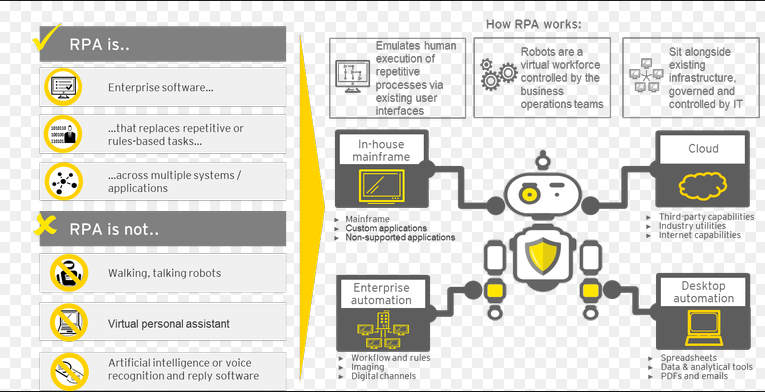
Source:ey.com
KPMG Global Sourcing advisory pulse survey is named as robotic revolution. The findings from this survey states that opportunities that arise from the implementation of Robotic Process Automation are several and come with adoption challenges. Some companies may find it challenging to harness the full potential of high end RPA opportunities. These difficulties can be easily overcome by making minor changes to the way the enterprise receives and executes the RPA technology.
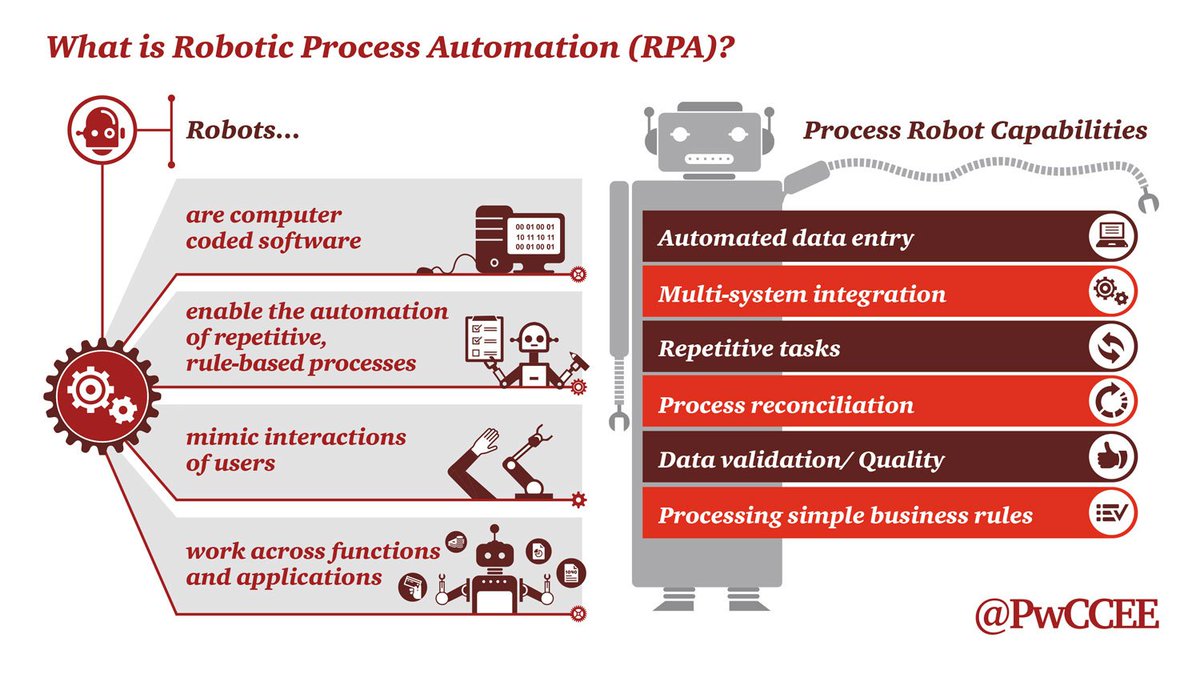
Source:pbs.twimg.com
It is always good to do a thorough analysis of the pros and cons before implementation of any new technology and this is especially applicable to RPA. Robotics Process Automation helps mainly in taking on business process roles.
We can examine the instance of an insurance provider thinking about automation needed to streamline various administrative roles and make business processes effectively. Such a provider will see and automation solution that will deliver transformation of back office processes as quickly as possible to tap into greater growth and agility in the overall business services. Using API implementation search and insurance enterprise can expect several advantages such as enhanced efficiency for claims processing to improve precision of manual data input and accelerated scalability matching volatile customer demand.
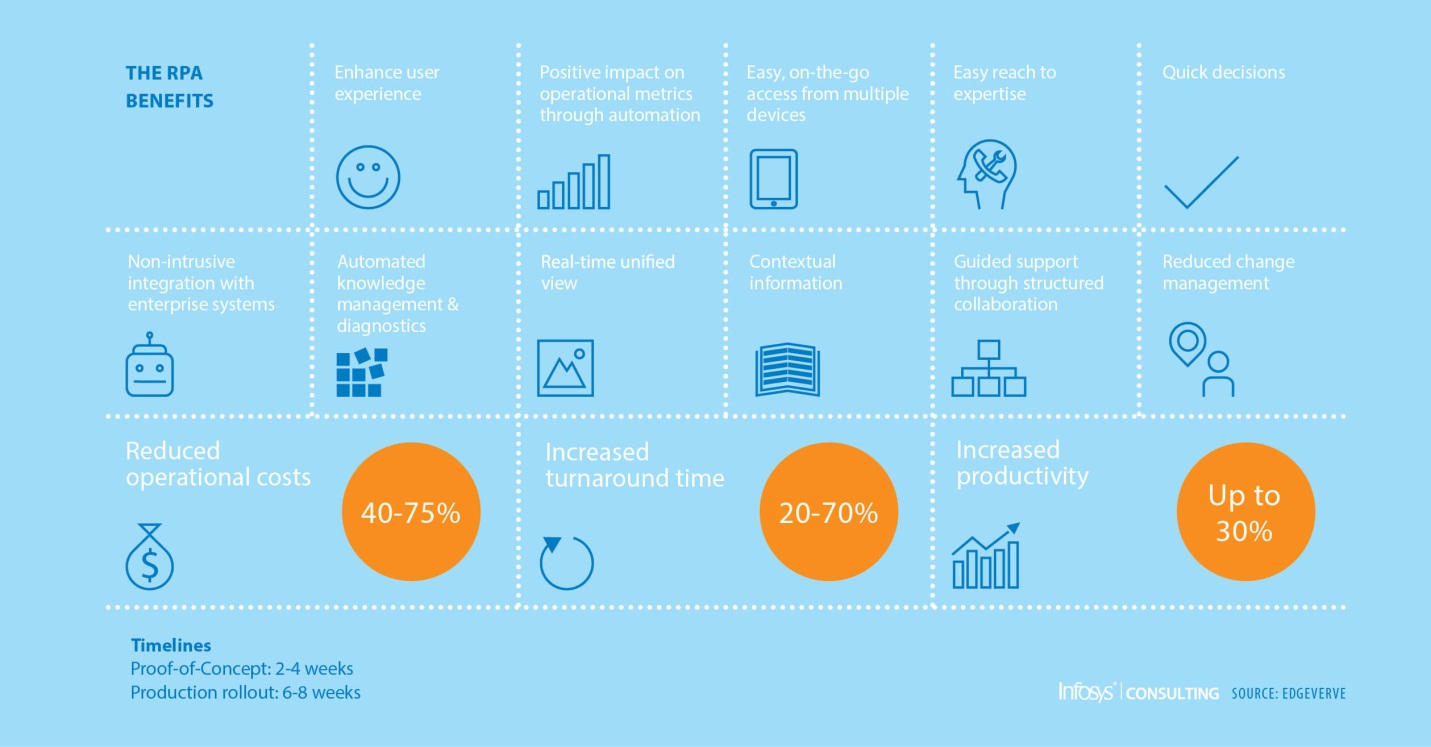
Source:infosysconsultinginsights.com
The advantages of ERP implementation aren’t as common as it seems. But there is great potential in the implementation of RPA:
Increased compliance
Robotic Process Automation eliminates data gaps between disparate logs and sources. This will enable employees in an organization to proactively identify and manage compliance issues comprehensively and progressively run reviews internally. These particular aspects of RPA support Enterprises across various industry verticals ranging from insurance providers to Healthcare Enterprises. Insurance providers will need to meet certain regulations such as the one set forth by IRDA in India, and Healthcare companies will need to meet higher medical standards proposed by medical boards of the respective states and countries.
Learn RPA Blue Prism from Industry Experts
Non-disruptive nature and compatibility with existing systems
RPA imitates human actions and the technology interacts with various data types within the presentation levels of applications and platforms. RPA functions as a user interface just as a human, where enterprises will not need to make modifications to pre-existing legacy systems when implementing RPA throughout the company. This is very useful as it permits enterprises to implement RPA or non-disruptive manner which makes this tool distinct amongst the pool of other automation tools. Another major advantage is a reduction in its administration and for employees to possess coding abilities.
Better management capabilities
Enterprises with the capability to remotely schedule modern control and monitor the deployment of RPA software robots benefit greatly from the centralized management platform. RPA also allows for analytics and auditing to happen simultaneously and in one location. RPA allows enterprises to achieve improved governance by embedding certain requirements within automation rules. Business operations management has done better due to this. Along with this there will be higher levels of security which can be regulated through remote server controls using software robots.

Source:image.slidesharecdn.com
Improved customer experience
RPA by enterprises as a means to relieve employees from the workload from repetitive tasks which are high volume, which includes issuing purchase orders and processing claims. It is hard to perceive the benefits received from automating back office tasks. But RPA does provide enhancement to customers, also using its automation capabilities it permits enterprises to provide higher quality service to the clients in a periodic manner.
The Challenges in implementation
Along with the benefits offered by Robotics Process Automation there also few challenges that crop up during implementation.
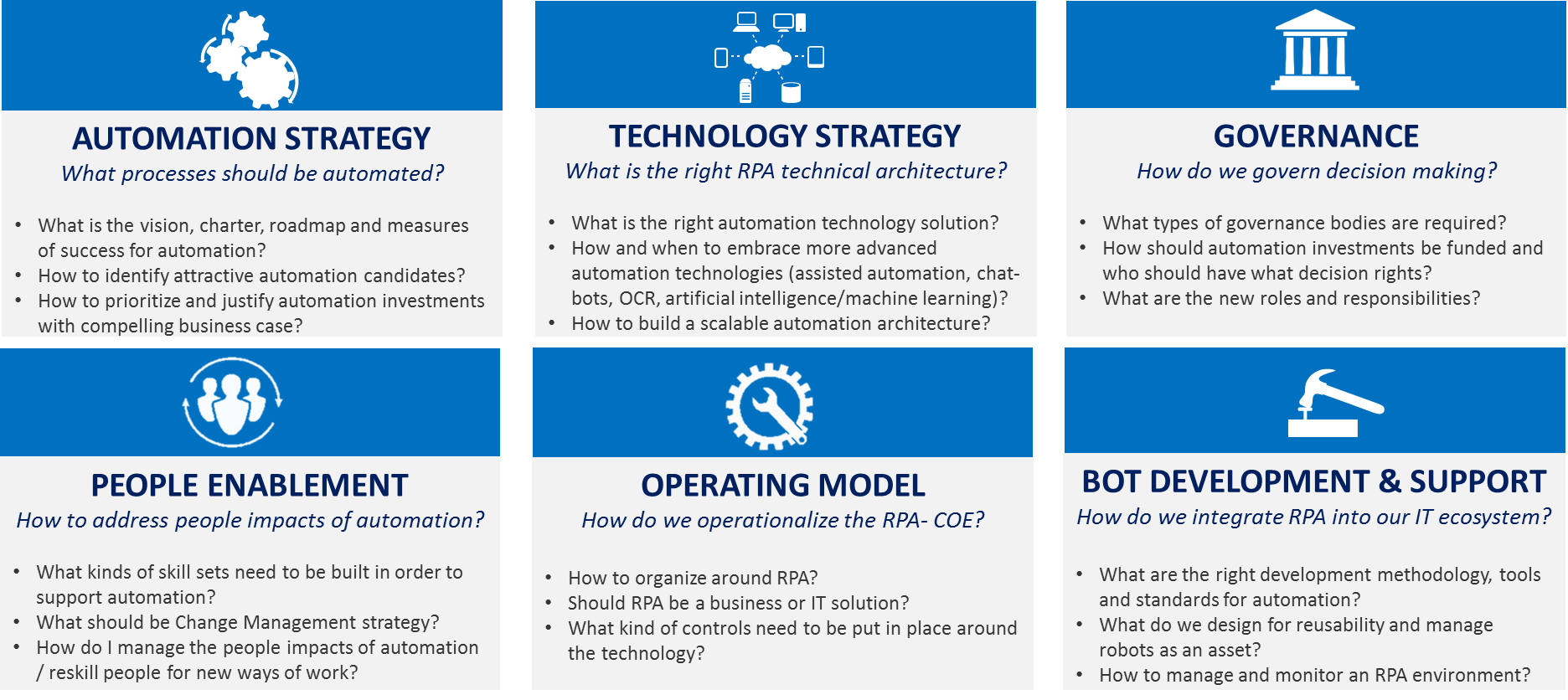
Source:infosysconsultinginsights.com
Given below are some such challenges that may turn up while implementing RPA:
Employee resistance and onboarding
All changes within an organization involving the introduction of new technology can be stressful for the company workforce as they may be a change in responsibilities. Such an obstacle can be overcome by periodic and consistent communication from higher management and company leadership to inform said employees of Management Expectations and long term plans of the implementation. Encouraging a work culture of innovation within the enterprise will definitely accelerate the adoption of a new technology.
Choosing the right processes
Best uses for RPA for rule-based high volume work which does not require cognitive abilities of higher degree. This can include anything from copy paste activities to data migration. The implementation of RPA is difficult when considering processes which are non-standardized and requires periodic human inputs for execution. Such complex tasks usually involve interacting with customers in real time and mastering human relationships and interactions. Companies have to be smart in deciding what aspect of the enterprise needs RPA so that the automation will run smoothly.
Setting realistic expectations
The biggest obstacle when implementing a new technology such as RPA is to see to realistic goals and eliminating ones which are not. Implementation will go a lot faster and be more effective when enterprises recognize the limits and scope of RPA and keep it in mind when planning implementation and executing the same. Customized implementation of RPA for each company will solve most problems related to this obstacle.
Overcoming the Challenges
The challenges mentioned above while adopting RPA are not inserted mountable and the right amount of planning and consideration will let enterprises to fully harness the power of RPA. When you consider it as a whole the competitive advantages offered by RPA to Enterprises will outweigh all the potential obstacles during implementation which are mostly teething troubles. Most surveys have revealed that Robotic Process Automation is a straight power technology that is easy to implement and provides great benefit for the investment that is put in.
Top 6 RPA advantages:
With the passage of time enterprises have decided to invest in automation of processes which are repeated such as payroll and invoice data capture. Human capital that is saved can be invested in more creative and complex tasks. Using RPA companies can get the best of both worlds by choosing only the aspects of automation, which beneficial to the company and leaving out the features which may add to the complexity. This is because long-term success in an enterprise can be achieved by striking a balance between human interfacing and robotic processing power.
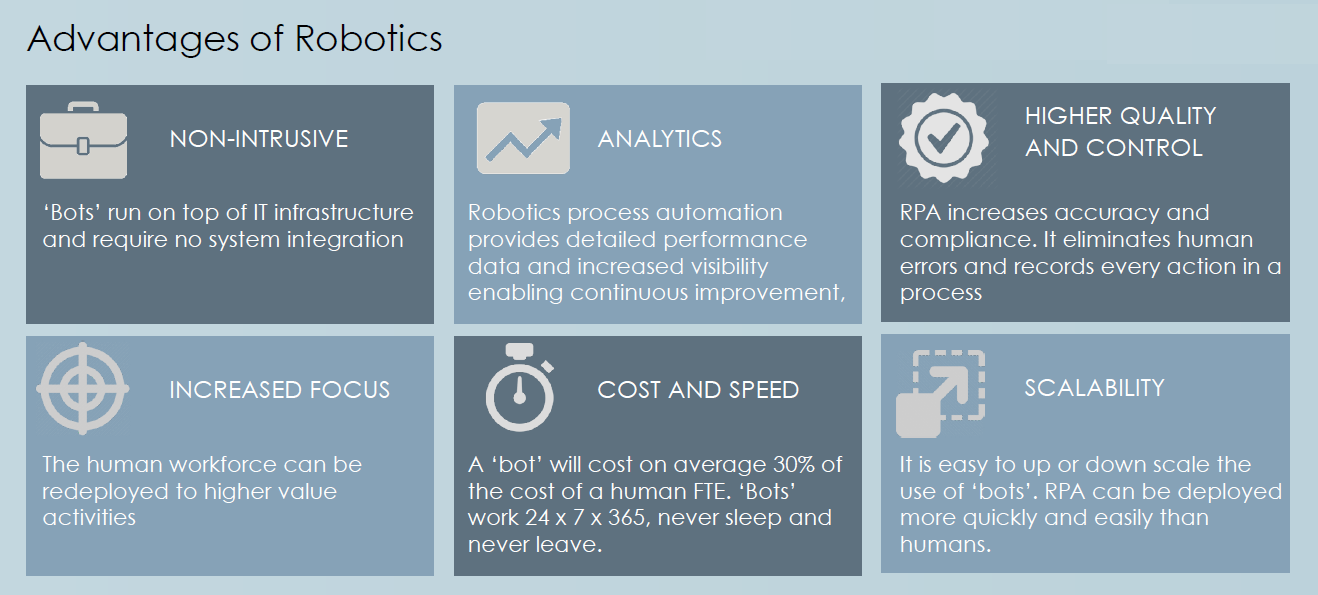
Source:prostream.co.za
When compared to the UK, USA, Europe, New Zealand and Australia are lagging behind with regard to implementation of Robotic Process Automation. But all regions of the world are rapidly catching up with the use of Robotic Process Automation.
How exactly does Robotic Process Automation help?
1. Robotic process automation is a useful tool for maximally efficient use of a company’s available resources.
Efficiency is achieved by cancelling out the risk of error. This risk is significantly high for dull repetitive tasks performed by humans because we are doomed to boredom and all its negative effects, such as suboptimal concentration and distraction.
Efficiency within an enterprise is obtained by eliminating or at least minimizing the probability of error. Errors are high when it comes to tasks that are monotonous and repetitive and also are performed by humans. Since your employees are prone to the forum and the negative effect it has on efficiency, the work suffers and more errors are created when it comes to repetitive tasks.
Senior Analysts in the automation industry have stated that the advantage of RPAis it provides personalized letters and auto sorted envelopes for mailing and also creating labels for mass mailing. This is an example taken from a mail merge application that makes use of robotic process automation
If you consider all letters that are returned because of unmarried actresses the associate cost of printing and the time cost involved in resending and handling search mails are significant. This is where Robotics Process Automation comes to the rescue, as address validation is strictly a rule-based process and can be easily automated using software robots. This will eliminate the need for any human intervention and without any possibility of error. A simple mail merge can be converted into a lean decision based process.

Source:totalebizsolutions.com
2. Robotic process automation is more than just a macro, or a shorthand representation for lines of code.
Industry experts have stressed on RPA being dynamic and adaptable tool which course way beyond inherent errors in macros and their limitations. These include the reliance on the designer who created the macro for solving any issue that comes forth. Macros are highly specific and highly customized solutions with very little scope outside of a narrow area within the task. If there are too many macros being used within a team or an organization, then it would require periodic management and updating.
The flexibility within RPA and its ability to adapt to any specific scenario makes it highly functional when compared with macros which are limited in their functionality and reflected in nature themselves. RPA provides a solution for new problems and new technologies that your organization may bring forth.
As opposed to macros, which are built in individual machines, RPA is installed on a server. This renders it more scalable than macros. It also makes Robotic Process Automation more cost-savvy, since it does not require supplementary training for its users as the number of automations running a process increases.
3. RPA and workflow tools are yin and yang, and businesses can use this to their advantage.
The major advantage is RPA and workflow tools are highly complementary, increasing each other’s efficiency and also increasing cost effectiveness. An RPA tool will usually wait for a signal from a workflow tool calling on it for completion of the process. When the RPA tool receives the signal it gets activated and complete the task and also finance is the process post which it provides feedback to the workflow tool.

Source:blog.appliedai.com
4. Robotic process automation enables high-level communication
Detailed benefits of RPA is that it can replace existing document automation tools and help in communicating meaningful and professional messages.
Such document automation software also manages all documentation of the company and ensures that our modifications are implemented consistently across the organization. In case an employee gets married and changes his/her second name, software such as this can change said name in a single document and save multiple stages in the process.
Robotic Process Automation can also be used to actually generate documents on automatic pieces by contrasting data that is stored in distinct systems. This basically means they can check the accuracy and update status of the data.
Learn RPA UiPath from Industry Experts
5. Robotic process automation enables users to schedule the realization of the automated processes.
Scheduling is used to execute routine tasks and is one of the core strengths of Robotic Process Automation software with scheduling abilities built into the system.
But it goes beyond scheduling in most ways. To summarize, there are two primary ways in which scheduled automation can be executed both with and without human inputs. Within attended automation the software for civil track a person is use of an application and run a support process when a specific action happens such as a mouse click. When it comes to unattended automation stimuli need not be by a person can be through other means such as when an email is received or a particular file is received online
6. Another advantage of Robotic Process Automation is that it does not need setting up an Application Programming Interface (API) before using RPA tools.
The elimination of and API is a major advantage, as API implementation is both time intensive and costly. EPS will also require a high level of expertise from an underlying system.
RPA software has an accelerated and readily available process for interacting with the application. This means that RPA has its own Graphical User Interface(GUI) which is easier to use and need a minimum amount of technical knowledge. RPA tools also execute the same as a person pressing buttons or clicking or even reading text using the same user interface.
Conclusion
Most of the general population is concerned about the disadvantages of automation back firing and losing out jobs to automation. But industry experts have highlighted that the positive effects will far outweigh the cons of Robotic Process Automation and say that it may fundamentally alter the way we work and perceive work on various levels.
The 6 advantages that were discussed above ultimately indicate that automation is actually helpful in making enterprises more efficient and employees more creative. Therefore work process in organizations across the world can be delayed relieved of repetitive tasks and allowed to pursue other tasks which have higher value addition to the company.


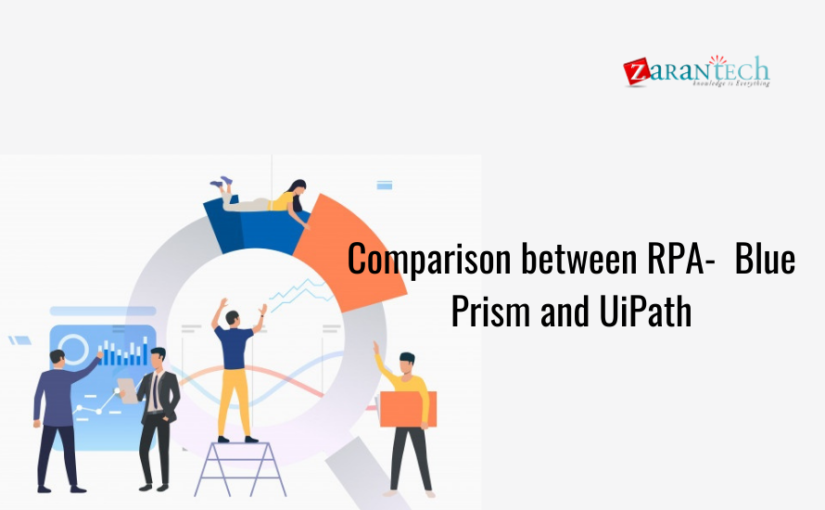


 99999999 (Toll Free)
99999999 (Toll Free)  +91 9999999
+91 9999999